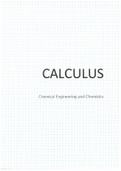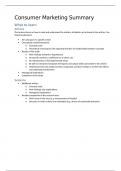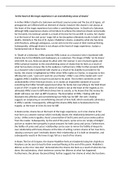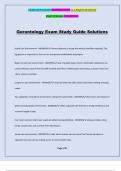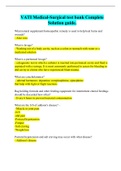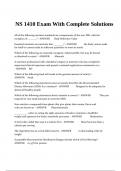Connective Tissue
Connective Tissue supports the softer organs of the body against gravity and connects the
parts of the body together. It also stores fat and produces the cells of blood.
Unlike Epithelial tissue, most connective tissues have few living cells. Most of their structure
consists of non-living extracellular material, the matrix that is synthesized by connective
tissue cells and released into the space between them. The strength of connective tissue comes
from the matrix, not from the living cells themselves. The few living cells rarely contact each
other, direct cell-to-cell junctions are not present.
Functions
- Found throughout the body
- Support structures → support strength comes from non-living extracellular
matrix
- Supports softer organs of the body Specialised connective
- Provides elasticity, structure, protection and
transport - Adipose
- Connects different tissues and connects - Cartilage
different organs - Bone
- Storage of fat - Blood
- Links epithelial tissue to underlying tissues Connective tissue proper
- Supports organs and links with blood and
blood vessels - Loose Connective tissue
- Produce blood cells - Dense fibrous
- Transport gasses, nutrients and waste
products
- Protect (immune defence)
Connective Tissue Proper
Type Structure Attributes Locations Function
Loose Mostly collagen and Flexible but Surrounds Binds epithelia to
(LCT) elastin fibres arrayed in only internal organs, underlying
a random pattern moderately muscles and tissues. Holds
strong blood vessels. organs in place.
more ground substance Found in skin
in ECM and throughout
body.
Dense Mostly collagen fibres Strong In tendons, In tendons, attach
Fibrous in a parallel ligaments and muscle to bones.
arrangement the lower In ligaments,
layers of the connect bones at
less ground substance skin joints.
in ECM
, Cells found in Loose Connective Tissue (LCT)
Fibroblasts Can migrate towards wounded tissue; produce fibres (secretes collagen and
elastin proteins; require Vit C) → to effectively seal off injured area
Adipocytes Stores lipids as droplets; brown adipocytes (many droplets); white
adipocytes (single big droplet)
Mast cells Secretes histamine and heparin; involved in allergic response
Macrophages Engulf bacteria and other foreign particles
Fibrous Connective Tissue
Ligaments Short bands/bundles of dense collagenous fibres → connect bones at joints
Tendons Short bands/bundles of dense collagenous fibres → connect muscle to bone
Connective Tissue Fibres
Collagenous fibres Provide strength and flexibility
Reticular fibres Join connective tissue to adjacent tissue
Elastic fibres Make tissues elastic
If you pinch a fold of tissue on the back of your hand, collagenous and reticular fibres prevent
the skin from being pulled far from the bone, whereas the elastic fibres restore the skin to its
original shape.
, Specialised Connective Tissue
Connective tissue consists of cells embedded in an extracellular matrix. This ECM consists
of fibres and ground substance.
Ground substance = jelly-like foundation, non-cellular component of matrix
Each specialised connective tissue has a
specialised matrix for a particular function:
Specialised Connective Tissue Matrix
Cartilage Rubbery matrix
Bone Solid matrix
Adipose Hardly any matrix
Blood Fluid matrix
Cartilage
Cartilage is the transitional tissue from which bone develops.
1. Matrix = collagen
2. Collagenous fibres embedded in a rubbery protein-carbohydrate complex →
chondroitin sulphate
3. Cells = chondrocytes; secrete collagen and chondroitin sulphate (rubbery) and together
form a strong yet flexible support material
4. Similar to dense fibrous CT as it contains collagen fibres
5. Chondroblasts mature into chondrocytes and are the ground substance of cartilage →
contain a lot of water → function well as a cushion (difference between dense fibrous
CT and cartilage)
6. As cartilage develops, chondrocytes become enclosed in small chambers called
lacunae.
7. No blood supply or lymphatic supply and movement of waste and nutrients is done
through diffusion to and from adjacent tissues → cartilage is slow to heal
Functions
- Firm, strong, flexible
- Transitional tissues from which bone develops
- Maintains shape of body parts (ears, nose)
- Cushions vertebrates (vertebral disks) and reduces
friction
- Lines joint cavities
- Flexible shock absorber
Connective Tissue supports the softer organs of the body against gravity and connects the
parts of the body together. It also stores fat and produces the cells of blood.
Unlike Epithelial tissue, most connective tissues have few living cells. Most of their structure
consists of non-living extracellular material, the matrix that is synthesized by connective
tissue cells and released into the space between them. The strength of connective tissue comes
from the matrix, not from the living cells themselves. The few living cells rarely contact each
other, direct cell-to-cell junctions are not present.
Functions
- Found throughout the body
- Support structures → support strength comes from non-living extracellular
matrix
- Supports softer organs of the body Specialised connective
- Provides elasticity, structure, protection and
transport - Adipose
- Connects different tissues and connects - Cartilage
different organs - Bone
- Storage of fat - Blood
- Links epithelial tissue to underlying tissues Connective tissue proper
- Supports organs and links with blood and
blood vessels - Loose Connective tissue
- Produce blood cells - Dense fibrous
- Transport gasses, nutrients and waste
products
- Protect (immune defence)
Connective Tissue Proper
Type Structure Attributes Locations Function
Loose Mostly collagen and Flexible but Surrounds Binds epithelia to
(LCT) elastin fibres arrayed in only internal organs, underlying
a random pattern moderately muscles and tissues. Holds
strong blood vessels. organs in place.
more ground substance Found in skin
in ECM and throughout
body.
Dense Mostly collagen fibres Strong In tendons, In tendons, attach
Fibrous in a parallel ligaments and muscle to bones.
arrangement the lower In ligaments,
layers of the connect bones at
less ground substance skin joints.
in ECM
, Cells found in Loose Connective Tissue (LCT)
Fibroblasts Can migrate towards wounded tissue; produce fibres (secretes collagen and
elastin proteins; require Vit C) → to effectively seal off injured area
Adipocytes Stores lipids as droplets; brown adipocytes (many droplets); white
adipocytes (single big droplet)
Mast cells Secretes histamine and heparin; involved in allergic response
Macrophages Engulf bacteria and other foreign particles
Fibrous Connective Tissue
Ligaments Short bands/bundles of dense collagenous fibres → connect bones at joints
Tendons Short bands/bundles of dense collagenous fibres → connect muscle to bone
Connective Tissue Fibres
Collagenous fibres Provide strength and flexibility
Reticular fibres Join connective tissue to adjacent tissue
Elastic fibres Make tissues elastic
If you pinch a fold of tissue on the back of your hand, collagenous and reticular fibres prevent
the skin from being pulled far from the bone, whereas the elastic fibres restore the skin to its
original shape.
, Specialised Connective Tissue
Connective tissue consists of cells embedded in an extracellular matrix. This ECM consists
of fibres and ground substance.
Ground substance = jelly-like foundation, non-cellular component of matrix
Each specialised connective tissue has a
specialised matrix for a particular function:
Specialised Connective Tissue Matrix
Cartilage Rubbery matrix
Bone Solid matrix
Adipose Hardly any matrix
Blood Fluid matrix
Cartilage
Cartilage is the transitional tissue from which bone develops.
1. Matrix = collagen
2. Collagenous fibres embedded in a rubbery protein-carbohydrate complex →
chondroitin sulphate
3. Cells = chondrocytes; secrete collagen and chondroitin sulphate (rubbery) and together
form a strong yet flexible support material
4. Similar to dense fibrous CT as it contains collagen fibres
5. Chondroblasts mature into chondrocytes and are the ground substance of cartilage →
contain a lot of water → function well as a cushion (difference between dense fibrous
CT and cartilage)
6. As cartilage develops, chondrocytes become enclosed in small chambers called
lacunae.
7. No blood supply or lymphatic supply and movement of waste and nutrients is done
through diffusion to and from adjacent tissues → cartilage is slow to heal
Functions
- Firm, strong, flexible
- Transitional tissues from which bone develops
- Maintains shape of body parts (ears, nose)
- Cushions vertebrates (vertebral disks) and reduces
friction
- Lines joint cavities
- Flexible shock absorber


